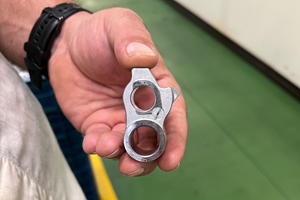Chip-Free Drilling Process Creates Holes And Bushings
This chip-free drilling technique can create both a hole and support bushing in thin-walled parts in one machining operation.
Share






Drilling holes in thin-walled parts isn’t hugely challenging. The process might require some means of workpiece support to counteract the pressure of the drill as it begins to penetrate the material. Depending on the application, the hole may also need to be deburred or chamfered.
Oftentimes, though, these holes must accept a bearing or fastener for component assembly. With conventional drilling, the hole’s thickness equals that of the workpiece, which likely isn’t suitable for threading or to provide sufficient support for a bearing sleeve. For that reason, it is often necessary to weld or rivet a nut to the workpiece, or install a special insert into the hole. The Flowdrill from Flowdrill Inc. (St. Louis, Missouri) eliminates the need for such devices by using a chip-free drilling technique that creates both a hole and support bushing in one machining operation.
The Flowdrill concept uses a conical drill that contacts material with high axial (downward) pressure and rotational speed. The frictional heat the drill generates softens the material, making it malleable enough for the drill to pierce the workpiece and form a collar and bushing around the hole. The total thickness of the collar (created on the top of the surface) and bushing (located under the surface) can be up to three times the workpiece thickness. This increased thickness offers support for a bearing or can be tapped with a similar Flowtap operation. The process works for wall thicknesses from 0.02 to 0.5 inch in mild and stainless steels, titanium, aluminum, copper, brass and various other malleable materials. Common applications include auto exhaust, steering and frame components; pressure and water tanks; pipes and tubing; HVAC manifolds; and metal furniture.
The tungsten carbide Flowdrills are available in diameters from 0.06 to 2 inches and can hold 0.0005-inch repeatability. They can be used on standard drilling machines or CNC machine tools, operating at power levels between 1.5 to 3.5 kW and spindle speeds from 1,000 to 3,500 rpm. The cutting parameters for each application will vary depending on hole diameter and workpiece material and thickness. To optimize hole quality and precision, lubrication must be applied prior to each operation. This can be done manually or via an automatic spraying system. Typical cycle times range from 2 to 6 seconds. Flowdrill collet toolholders are available with a #2 and #3 Morse Taper shank or a 20-mm straight cylindrical shank.
For applications requiring a smooth joining surface or a chamfered hole, flat Flowdrill versions can be used to cut the collar that is formed on the surface of the workpiece. Fluted-tip Flowdrills are recommended for coated materials because the tip helps remove the coating at the start of the drilling operation. Fluted Flowdrills also help prevent the deformation of thin workpieces that can occur because of the drill’s downward pressure. This distortion can also be avoided by drilling a small starter hole.
Flowtap roll forming taps can be used to create various standard, metric and NPT thread profiles. Because they form the threads rather than cut them, a compressed structure is created. This structure offers high pull-out strength and torque specifications.
Related Content
Finding the Right Tools for a Turning Shop
Xcelicut is a startup shop that has grown thanks to the right machines, cutting tools, grants and other resources.
Read MoreCustom PCD Tools Extend Shop’s Tool Life Upward of Ten Times
Adopting PCD tooling has extended FT Precision’s tool life from days to months — and the test drill is still going strong.
Read MoreThe Future of High Feed Milling in Modern Manufacturing
Achieve higher metal removal rates and enhanced predictability with ISCAR’s advanced high-feed milling tools — optimized for today’s competitive global market.
Read MoreMeasuring Torque, Thrust Force for Smart Drilling Operations
To monitor drilling operations for smart manufacturing solutions, torque and thrust force can be measured.
Read MoreRead Next
Machine Shop MBA
Making Chips and 91±¬ÁĎÍř are teaming up for a new podcast series called Machine Shop MBA—designed to help manufacturers measure their success against the industry’s best. Through the lens of the 91±¬ÁĎÍř benchmarking program, the series explores the KPIs that set high-performing shops apart, from machine utilization and first-pass yield to employee engagement and revenue per employee.
Read MoreAMRs Are Moving Into Manufacturing: 4 Considerations for Implementation
AMRs can provide a flexible, easy-to-use automation platform so long as manufacturers choose a suitable task and prepare their facilities.
Read More




















